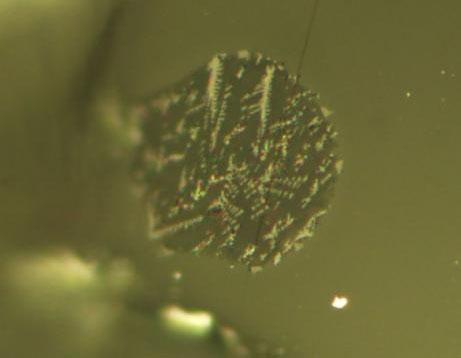
by Abaan Ahmed Momin Tuesday, February 2, 2016

Tiny inclusions of lunar magma, such as this one, trapped inside olivine crystals offer clues to the composition and origins of the moon. Credit: Saal Lab/Brown University
The moon was once thought to be virtually devoid of water and other volatile materials — a presumed consequence of extreme heating during its formation. But a recent study of lunar volcanic glasses, from samples brought back by the Apollo 15 and 17 missions, is adding to the growing stack of recent evidence suggesting the moon is not the volatile-free place scientists once suspected. The findings bring us one step closer to understanding the moon’s origins.
The basaltic volcanic glasses are thought to have been formed during explosive fire-fountain eruptions billions of years ago on the moon. Such lava eruptions are common on Earth today, and are typically caused by trapped gases that escape the magma as it reaches the surface. But until recently, the gases that might have escaped the lunar magmas and caused fire-fountain eruptions on the moon weren’t known.
In 2008, researchers led by Alberto Saal, a planetary scientist at Brown University, discovered water in the lunar volcanic glasses. Later work also detected the presence of hydrogen, fluorine, sulfur, chlorine and other elements frequently found in volcanic volatiles.
On Earth, fire fountains are driven mainly by the degassing of water or carbon dioxide. Conditions in the upper mantle of the moon, however, make it unlikely that water — or gases bearing fluorine, chlorine or sulfur — would have degassed from lunar magmas and caused the eruptions, says Saal, who is co-author of the new study, published in Nature Geoscience. “Carbon, on the other hand, is not very soluble in silicate melts and degasses very easily from the melt,” he says, making it the most likely reason for the creation of the lunar volcanic glasses. But the carbon content in the glasses has not been well constrained, partly because measurement techniques were not advanced enough.
In the new study, Saal’s team used a technique called secondary ion mass spectrometry, which is sensitive to low concentrations of carbon, to analyze lunar volcanic glasses as well as tiny melt inclusions within olivine mineral crystals that erupted along with the glass particles. Whereas the glasses preserve evidence of the degassing history of the lunar magmas, the melt inclusions are significant because they represent bits of original volcanic material trapped before the magma erupted at the surface. This trapped melt is thus safe from volatile loss that might occur due to degassing and can be used to determine the initial concentrations of gases in the magma.
The researchers found that the concentrations of carbon and water in the glass particles varied, but both tended to decrease progressively from the center to the rim. In particles with higher total volatile contents — meaning they’d undergone relatively little degassing — the team also observed that there was more variation in carbon concentrations than variation in water concentrations. Meanwhile, in particles with lower volatile contents overall — meaning most of the gases had escaped from these particles — the variation in water concentrations was greater than the variation in carbon concentrations. Combined, the observations indicated that carbon — in the form of carbon monoxide — degassed first from the lunar magmas and initially drove the fire-fountain eruptions, followed by water degassing.
The group also found that the carbon content of the melt inclusions was about 50 parts per million: “nearly equivalent to that measured on the Earth from the basalts at the mid-oceanic ridges,” Saal says. The finding suggests that the moon and Earth might share a common origin for their volatiles.
Determining the amount of volatiles lost during the degassing of lunar magmas is important for calculating the moon’s original volatile composition, Saal says. Models for the moon’s formation, such as the Giant Impact Hypothesis, “indicate a large loss in the amount of volatiles during the formation of the moon,” he notes. However, the amounts of volatiles detected in the moon in recent research vary drastically from “the extreme amounts that people thought it had lost during the impact, by a factor of 20 to 100.” The researchers “definitively show that carbon is present as a dissolved species in the erupted melt phase of lunar magmas, and suggest that there is sufficient dissolved carbon to drive fire-fountain eruptions,” wrote Bruno Scaillet of the Institute of Earth Sciences of Orléans in France in a commentary on the work in the same issue of Nature Geoscience. The results also offer “further evidence that the Earth and moon may share a common volatile source,” he wrote.
There are, however, still questions to be answered, Scaillet wrote. For example, “despite similar volatile contents,” it’s unclear why the lunar glasses are less oxidized than the terrestrial mid-ocean ridge basalts. Finding the answer, he noted, which might relate to differences in the respective mantles of the moon and Earth, where volcanic magmas originate, may inspire further efforts to understand the moon’s mysterious background.
© 2008-2021. All rights reserved. Any copying, redistribution or retransmission of any of the contents of this service without the expressed written permission of the American Geosciences Institute is expressly prohibited. Click here for all copyright requests.